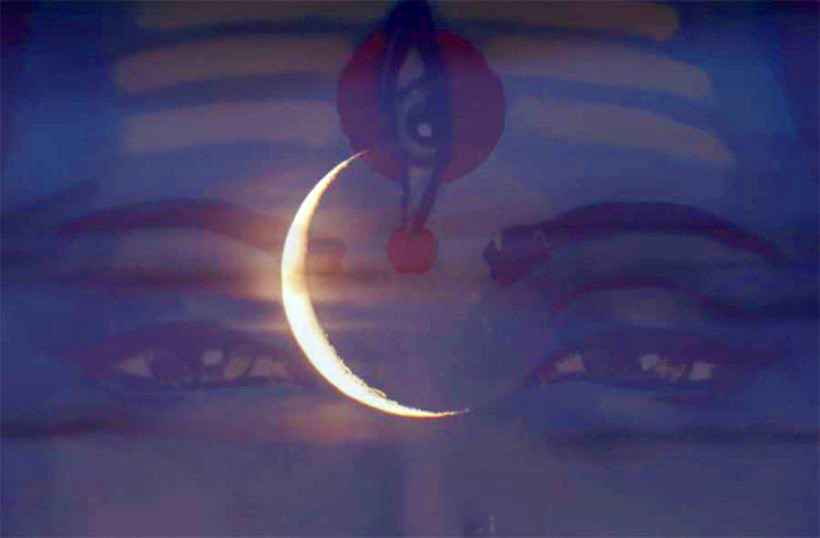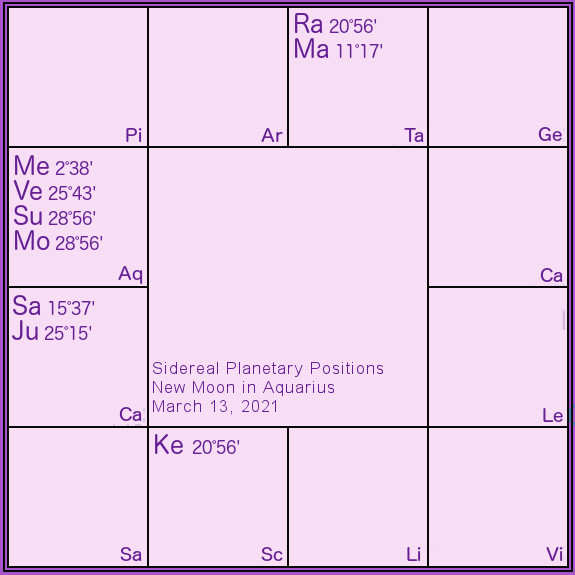New Moon and Maha Shivaratri, March 2021
The Sun and Moon join near the end of sidereal Aquarius on the dark night of March 12th, with an exact alignment under the New Moon at 5:21 am ET on Saturday, March 13th. Mercury and Venus also join the Moon and Sun in Aquarius, while Saturn (with Jupiter in sidereal Capricorn) once again rules over 6 grahas at the time of the New Moon. Mars and Rahu continue their conjunction in sidereal Taurus, opposite Ketu in Sagittarius, forming a Kala Sarpa Yoga in the sky. Thursday night, the fourteenth night of the waning Moon, marks the Maha Shivaratri celebration this month. Sun and Moon begin this cycle in the Vedic nakshatra Purva Bhadrapada, an auspicious sign for spiritual advancement.
Aquarius Cycle
With the new lunar cycle beginning in Aquarius, the coming month may have a quirky and forward-thinking tone, and we may see some scientific advances this month. The Mars Rover landing actually occurred just days after the Sun had entered its Aquarius cycle. Aquarius is in fact very much about service to the greater good. With Saturn strong in his own sign, we could see many significant advances in social support structures right now.
Aquarius is known as Kumbha in Sanskrit, a word for “pitcher” or “vessel.” According to the Vedic texts, the sign Kumbha can be imagined as a man holding a pot, with deep-brown skin, standing in the water. We can see this Aquarian imagery in the sadhus of India (and its biggest ritual pilgrimage day, the Kumbha Mela), who make their lives an offering of service to society through their prayers and Saturnian austerities, while renouncing the individual self. In the Aquarius cycle, we think about how we can serve the whole.
Maha Shivaratri
Thursday night, March 11th in North America, the night prior to the Dark Moon night, is the fourteenth waning phase of the lunar cycle. During this month this night is celebrated as Maha Shivaratri. This is the most auspicious night of the year for doing sadhana (spiritual practice). It is traditional on this night to stay up all night fasting, chanting, praying, and meditating. This holiday honors Lord Shiva, the great ascetic, as we recall two stories of great sacrifices that he made protect the entire creation.
One of these is the story of the gods and demons churning of the milk ocean in order to release the nectar of immortality. Before the nectar came up, however, a poison came up first. (This is similar to when we do spiritual practice and begin our path of self-inquiry, and negative tendencies often come to light first, which can be a painful experience. Similarly, during a physical fast or cleanse, toxins can be shaken loose and released first, causing a healing crisis before we continue healing into a freer, happier state of being.) When the poison came up from the milk ocean, Lord Shiva consumed it so that it would not engulf humanity, as a great and noble sacrifice. His wife, Parvati, however, held his throat so that he could not ingest it, thus saving him from being harmed by the poison.
Maha Shivaratri also commemorates the wedding of Shiva and Parvati, which also stemmed from great sacrifice made for the benefit of all humanity. It was said that after his first wife, Sati, perished, Shiva was fully devoted only to his sadhana, meditating for aeons in isolation and renouncing the world. Then the demon Tarakasura began running amock on earth, threatening all of humanity. Brahma foretold that only Shiva’s child could defeat Tarakasura, so the gods devised a plan for Sati to reincarnate as Parvati, and win over her Lord to marriage once again to produce this heir. Shiva was not easily swayed, however, and it was only after Parvati became an ascetic and underwent great penance that he agreed to marry. They eventually produced their son Kartikkeya, who went on to slay the demon.
Thus, this holiday is celebrated through the penance of fasting, forgoing food, water, and sleep, for one night, and simultaneously celebrating the union of Lord Shiva and Parvati, or the masculine and feminine energies of creation, that allows the dance of life to continue. It is an apt time to feel the forces of Aquarius upon us, which compel us to consider our role in society, and in the universe, and what personal sacrifices we can make for the greater good. Even if you’re not able to stay up the whole night, any amount of devotional practice, serviceful sacrifice, or chanting of Om Namah Shivaya on this night can have beneficial affects that are magnified greater than on any other night.
Kala Sarpa Yoga
This year’s Kala Sarpa yoga cycles continue, as Rahu and Ketu appear to cut the sky in half with all planets to one side of the nodal axis. Kala Sarpa can be translated as “black snake” or the “serpent of time,” and intensifies subtle forces on all levels, including inner challenges as well as strengths and yogic combinations in a chart. Mars joins Rahu in Taurus, and tho he will transit out of Taurus and into Gemini in one month, technically breaking the cycle, the intensity brought on by the alignment can sometimes continue when only one planet has crossed to the other side of the sky.
Purva Bhadrapada
The former “lucky-footed one” is the Vedic nakshatra (star-sign) where Sun and Moon begin this lunar cycle. This nakshatra bridges Aquarius and Pisces and is often represented by a funeral cot, symbolizing the transition from life into death, or ultimate liberation. It is ruled by Aja Epakada, the one-footed goat who is often associated with the image of Lord Shiva as Nataraj dancing on one foot, a fitting image for Maha Shivaratri.
Om Namah Shivaya!


